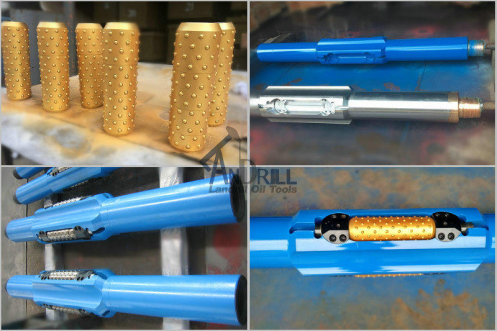When designing, selecting, or purchasing a Roller Reamer Cutter, material and dimensions are critical factors that directly affect its performance, lifespan, and application. Below are the key considerations:

1. Material Selection Considerations
The main wear components of a Roller Reamer Cutter are the roller cutters and the body. Material selection must account for hardness, wear resistance, impact toughness, and high-temperature resistance.
(1) Roller Cutter Material
-Tungsten Carbide (WC)
- The most common choice, offering high hardness (HRA 90+) and wear resistance.
- Suitable for medium-hard to extremely hard formations (e.g., granite, quartzite).
- Pay attention to cobalt (Co) content (6%~15%)—higher cobalt improves toughness but reduces hardness.
- PDC (Polycrystalline Diamond Compact)
- Suitable for soft to medium-hard formations, with excellent wear resistance but low impact resistance.
- Commonly used in oil drilling and geological exploration.
- Ceramic or Ultra-Hard Coatings (e.g., TiN, DLC)
- Used in highly abrasive environments but at a higher cost.
(2) Body Material
- Alloy Steel (e.g., 4140, 4340)
- Requires quenching and tempering (QT) heat treatment to enhance strength and toughness.
- Stainless Steel (e.g., 17-4PH)
- Used in corrosive environments (e.g., offshore drilling, acidic formations).
- Surface Treatments (e.g., chrome plating, nitriding) can improve wear resistance.
Key Material Selection Points:
✅ Choose roller cutter material based on formation hardness (hard rock → tungsten carbide, soft rock → PDC).
✅ Consider impact loads to avoid brittleness and cracking.
✅ For corrosive environments (e.g., saltwater, H₂S), use stainless steel or special coatings.
—
2. Dimension Considerations
The dimensions of a Roller Reamer Cutter directly affect its compatibility with borehole diameter, stability, and cutting efficiency.
(1) Outer Diameter (OD)
- Must match the target borehole diameter (typically slightly larger than the drill bit for hole conditioning).
- Consider tolerances (±0.1~0.5mm) to ensure reaming accuracy.
- In oil drilling, must comply with API standards (e.g., API 7-1).
(2) Length
- Affects stability—longer reamers provide better guidance but may increase friction.
- Typical range: 200mm ~ 1500mm (depending on application).
(3) Number and Arrangement of Cutters
- 3~6 roller cutters are most common—more cutters improve stability but increase torque demand.
- Helical arrangement reduces vibration, suitable for deep-hole drilling.
(4) Connection Type (Thread)
- API threads (e.g., NC50, 6 5/8″ REG) for oil drilling tools.
- Special connections (e.g., IF, FH) must match the drill string.
Key Dimension Selection Points:
✅ OD must match the target borehole size, accounting for wear over time.
✅ Length-to-diameter ratio (L/D) affects stability—longer reamers are better for deep holes.
✅ Thread connections must be compatible with the drill string to prevent downhole failures.
—
3. Other Critical Parameters
- Maximum RPM: Affects cutter lifespan—must be set based on material and lubrication.
-Operating Temperature: High-temperature environments (e.g., deep wells) require heat-resistant alloys.
- Mud/Coolant Compatibility: Ensure materials resist corrosion from drilling fluids.
Summary: Selection Checklist
|Item | Considerations |
|————–|————|
| Roller Cutter Material | Tungsten carbide (hard rock), PDC (soft rock), impact resistance |
| Body Material | Alloy steel (4140), stainless steel (17-4PH) |
| Outer Diameter (OD) | Match target hole size, consider tolerances |
| Length | Length-to-diameter ratio (L/D) affects stability |
| Number of Cutters | 3~6 cutters, helical arrangement reduces vibration |
| Connection Type | API standard threads (NC50, REG) |
|Operating Environment | Temperature, corrosion, impact loads |
Junnie Liu
Mobile/Whatsapp:+0086-158 7765 8727
Email: landrill@landrilltools.com
Post time: May-23-2025








 Room 703 Building B, Greenland center, Hi-tech development zone Xi’an, China
Room 703 Building B, Greenland center, Hi-tech development zone Xi’an, China
 86-13609153141
86-13609153141


